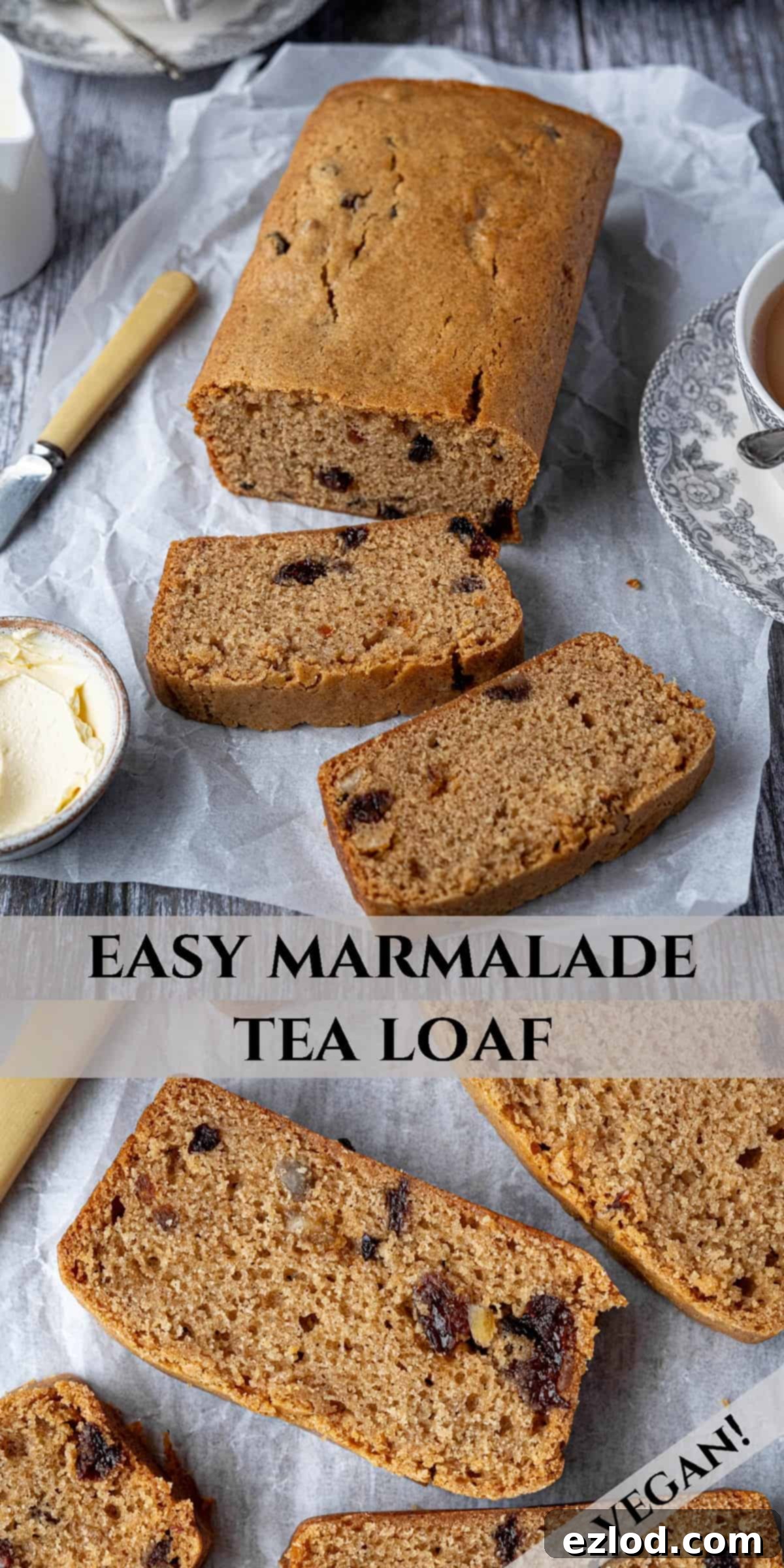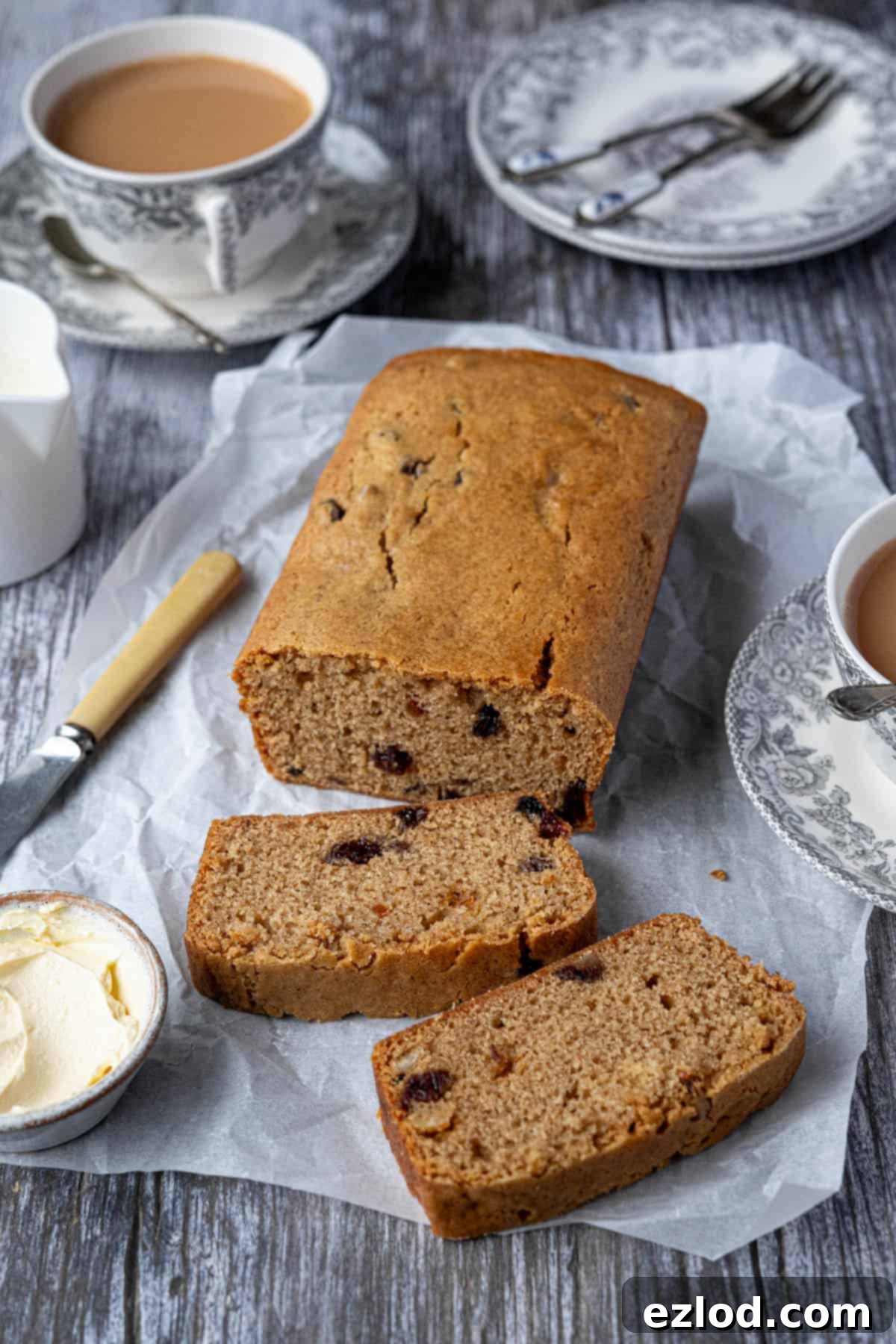Delicious Vegan Marmalade Tea Loaf: An Easy & Flavorful Plant-Based Cake Recipe
Discover the ultimate indulgence with this incredibly easy vegan marmalade tea loaf! This simple yet exquisitely delicious plant-based loaf cake is a true delight, masterfully infused with the bright zest of marmalade, the rich sweetness of golden syrup, a warming blend of aromatic spices, and a generous medley of dried fruits. Perfectly moist and wonderfully flavorful, it’s a staple for any vegan baker.
Despite its name, this marmalade tea loaf doesn’t actually contain tea as an ingredient. Instead, it embodies the spirit of traditional tea cakes – a comforting and delightful bake that finds its perfect companion alongside a steaming hot pot of tea. It’s an ideal treat to enjoy as a leisurely mid-morning snack, an elegant afternoon tea accompaniment, or simply whenever you crave a slice of homemade goodness. This recipe proves that vegan baking can be both effortless and utterly satisfying.
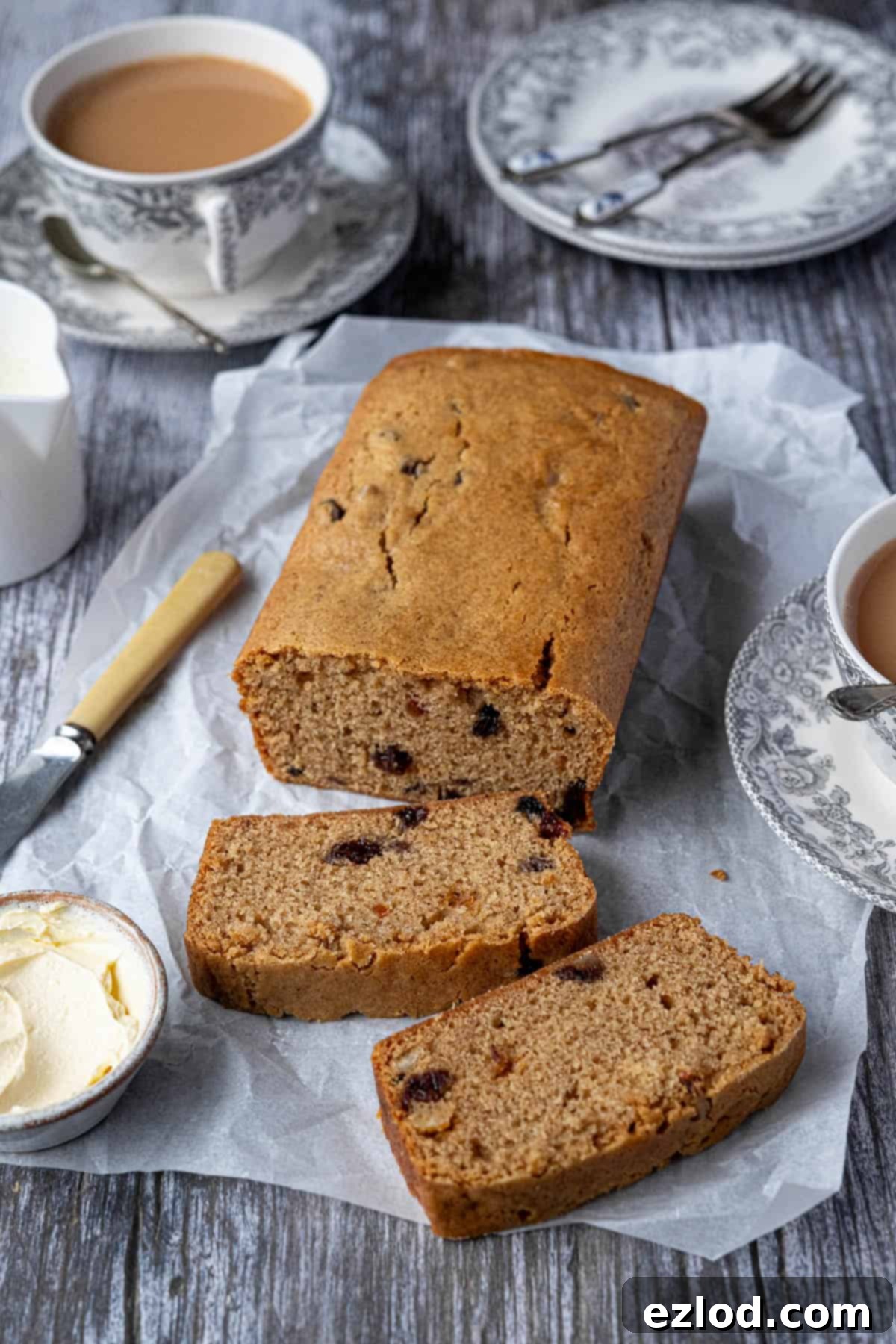
The inspiration for this easy marmalade tea loaf comes from a deeply cherished, classic Be-Ro flour cookbook – a treasured source of traditional British baking recipes. I stumbled upon the original, non-vegan version of this delightful cake on the charming blog Lavender and Lovage. Instantly, I knew I had to adapt it, creating a wonderfully accessible vegan rendition that retains all the warmth and comforting flavors of the original, making it suitable for everyone to enjoy.
What truly sets this recipe apart is its remarkable simplicity. It’s a fuss-free, one-pan wonder, designed to minimize effort and maximize flavor. The process couldn’t be easier: you simply combine and melt the vegan butter, fragrant marmalade, sticky golden syrup, and sugar in a single pan. After allowing this rich mixture to cool slightly, you effortlessly stir in the remaining dry ingredients, transforming them into a smooth, ready-to-bake batter. This streamlined method makes it perfect for both novice bakers and seasoned pros looking for a quick and rewarding project.
This recipe yields a moderately sized loaf cake, making it an excellent choice for smaller households or individuals. It stores beautifully in an airtight tin for several days, ensuring you can enjoy a fresh slice whenever the craving strikes. Its convenient size also means it’s less likely to go stale, offering perfect portions for a couple or a small family without overwhelming you with leftovers.
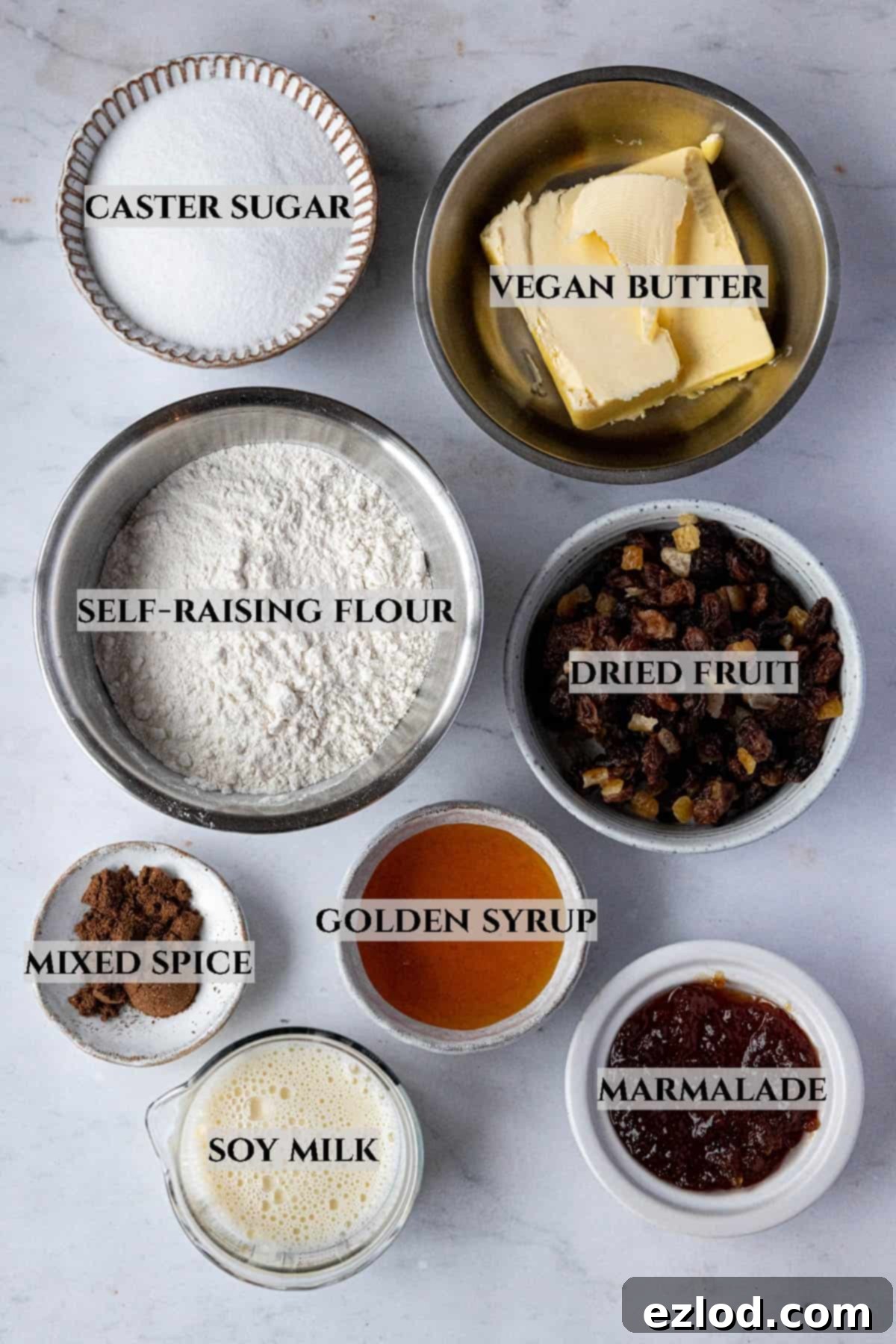
Essential Ingredient Details for Your Vegan Marmalade Tea Loaf
Crafting the perfect vegan marmalade tea loaf begins with understanding each ingredient and its role. Here’s a deeper dive into the components that make this cake so special, along with helpful tips for substitutions and best practices.
- Marmalade: The star of the show! I typically opt for a thick-cut orange marmalade as its robust citrus notes and chunky texture really shine through, offering delightful pockets of fruity bitterness that balance the sweetness. However, a fine-shred marmalade will also work beautifully, imparting a more subtle, diffused citrus flavor throughout the loaf. Feel free to experiment with different citrus varieties, such as lemon or grapefruit marmalade, for unique flavor profiles.
- Vegan Butter: The fat content is crucial for a moist and tender crumb. Both block vegan butter (like Miyoko’s Kitchen or Violife) and spreadable vegan butter alternatives are suitable for this recipe. However, it’s vital to avoid ‘light’ varieties, as their lower fat content can negatively impact the cake’s texture and richness. My personal preference, and what I used for testing, is Flora Plant Butter, which offers excellent baking performance.
- Non-Dairy Milk: Any unsweetened non-dairy milk will seamlessly integrate into this recipe. My go-to is soy milk due to its neutral flavor and good protein content, which aids in baking. Other excellent options include almond milk, oat milk, or rice milk. The only exception to avoid is tinned coconut milk, as its high fat content and distinct flavor profile are not suitable for this particular recipe.
- Golden Syrup: A truly iconic British baking ingredient, golden syrup is a thick, amber-colored inverted sugar syrup with a distinctive buttery, caramel-like flavor and a viscosity similar to honey. Good news for vegans: Lyle’s Golden Syrup, the most well-known brand, is indeed vegan-friendly! While Lyle’s is widely available, supermarket own-brand golden syrups are also perfectly fine and often more economical – and precisely what I use. Its unique flavor and texture are key to this loaf’s character.
- Self-Raising Flour: This type of flour (known as self-rising in the US) is ideal here because it already contains leavening agents (baking powder and a pinch of salt), simplifying the recipe. If you cannot find self-raising flour, don’t worry! You can easily create your own by adding 1 ½ teaspoons of baking powder to every 175g of plain (all-purpose) flour. While I haven’t specifically tested this conversion for this recipe, it’s a standard baking substitution that typically yields good results.
- Sugar: For sweetness and structure, I typically use caster sugar (superfine granulated sugar), which dissolves easily and creates a fine crumb. However, regular granulated sugar works just as well. For a deeper, more molasses-like flavor and a slightly moister texture, you could also use light brown soft sugar or even coconut sugar as alternatives. It’s important not to substitute with liquid sugars like maple syrup or agave nectar, or artificial sweeteners, as these will drastically alter the cake’s moisture balance and overall structure.
- Mixed Spice: A cornerstone of traditional British baking, especially during festive seasons, mixed spice is a delightful blend of sweet, aromatic spices. It typically includes cinnamon, nutmeg, ginger, allspice, and cloves, among others. While it shares similarities with pumpkin spice, mixed spice generally has a different balance, often less heavy on the cinnamon. If you’re outside the UK and can’t find it, a good quality sweet spice blend such as pumpkin pie spice or apple pie spice can be used as a suitable alternative, offering a similar warm and comforting aroma.
- Mixed Dried Fruit: This adds chewiness, natural sweetness, and bursts of flavor throughout the loaf. I usually opt for a readily available shop-bought mix containing raisins, sultanas (golden raisins), currants, and candied peel. This combination provides a varied texture and flavor. If you prefer, using just sultanas works wonderfully. For a delightful twist, consider adding dried cranberries or chopped dried apricots for a different tartness and color. You can also rehydrate your dried fruit by soaking it in hot water or a little rum for 10-15 minutes before adding, ensuring an even moister result.
Exploring Golden Syrup Substitutes: What to Do If You Can’t Find It
Golden syrup is an integral part of many UK baking recipes, prized for its unique buttery-caramel notes and thick, smooth consistency, reminiscent of honey. While it’s a common pantry item in Britain, it can be a little elusive elsewhere. Many specialty food stores or international aisles in larger supermarkets in the US and other countries often stock it, and it’s always readily available online. For the adventurous baker, you can even try making your own golden syrup from scratch at home, which can be a fun project!
Because of its distinct flavor profile and texture, there isn’t a perfect, one-to-one substitute for golden syrup that will replicate its exact qualities. However, if you’re unable to source it and prefer not to make it yourself, you do have a couple of viable alternatives. Light molasses (sometimes called “mild” or “unsulphured” molasses) can be used, but be aware that it has a stronger, more robust flavor than golden syrup, so you might want to use slightly less. Alternatively, light corn syrup can mimic the texture and provide sweetness, but it lacks the characteristic caramel depth of golden syrup. A combination of corn syrup with a touch of molasses might get you closer to the desired flavor. Remember, any substitution will alter the final taste and texture slightly, but the loaf will still be delicious!
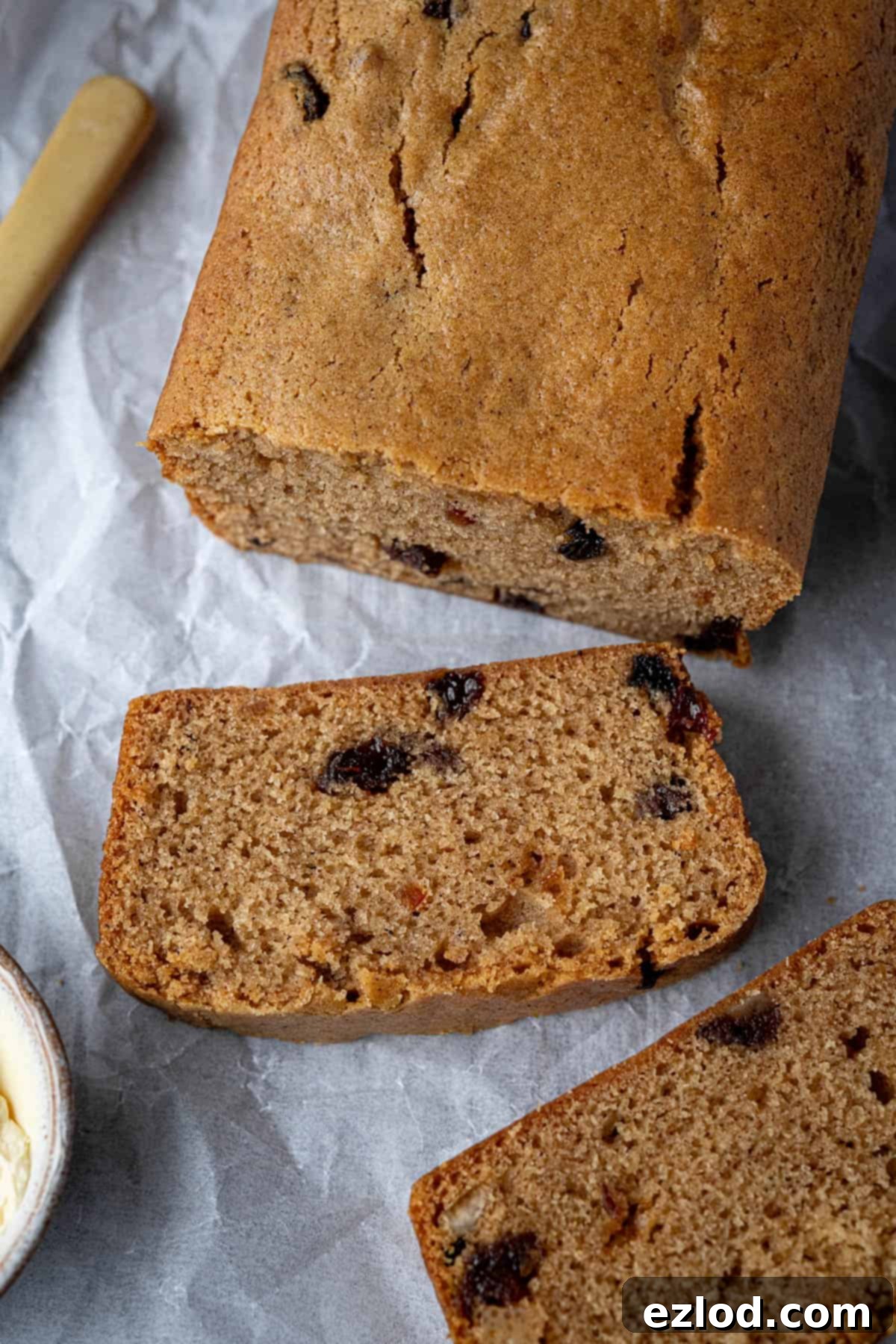
How To Master Your Easy Vegan Marmalade Tea Loaf: A Step-by-Step Guide
(For precise measurements and full instructions, please refer to the detailed recipe card conveniently located at the bottom of this page.)
Creating this delightful vegan marmalade tea loaf is surprisingly straightforward. Follow these simple steps for a perfect bake every time:
Step 1: Melt the Wet Ingredients. Begin by combining the vegan butter, fragrant marmalade, sticky golden syrup, and sugar in a sturdy saucepan. Place the pan over a gentle, low heat. Stir continuously until all the ingredients have fully melted together and formed a smooth, homogenous mixture. This ensures even distribution of flavors and sweetness. Once melted, remove the pan from the heat. Stir in the non-dairy milk and allow the mixture to cool down for approximately 5 to 10 minutes. It should be warm, not hot, to avoid scrambling the flour later.
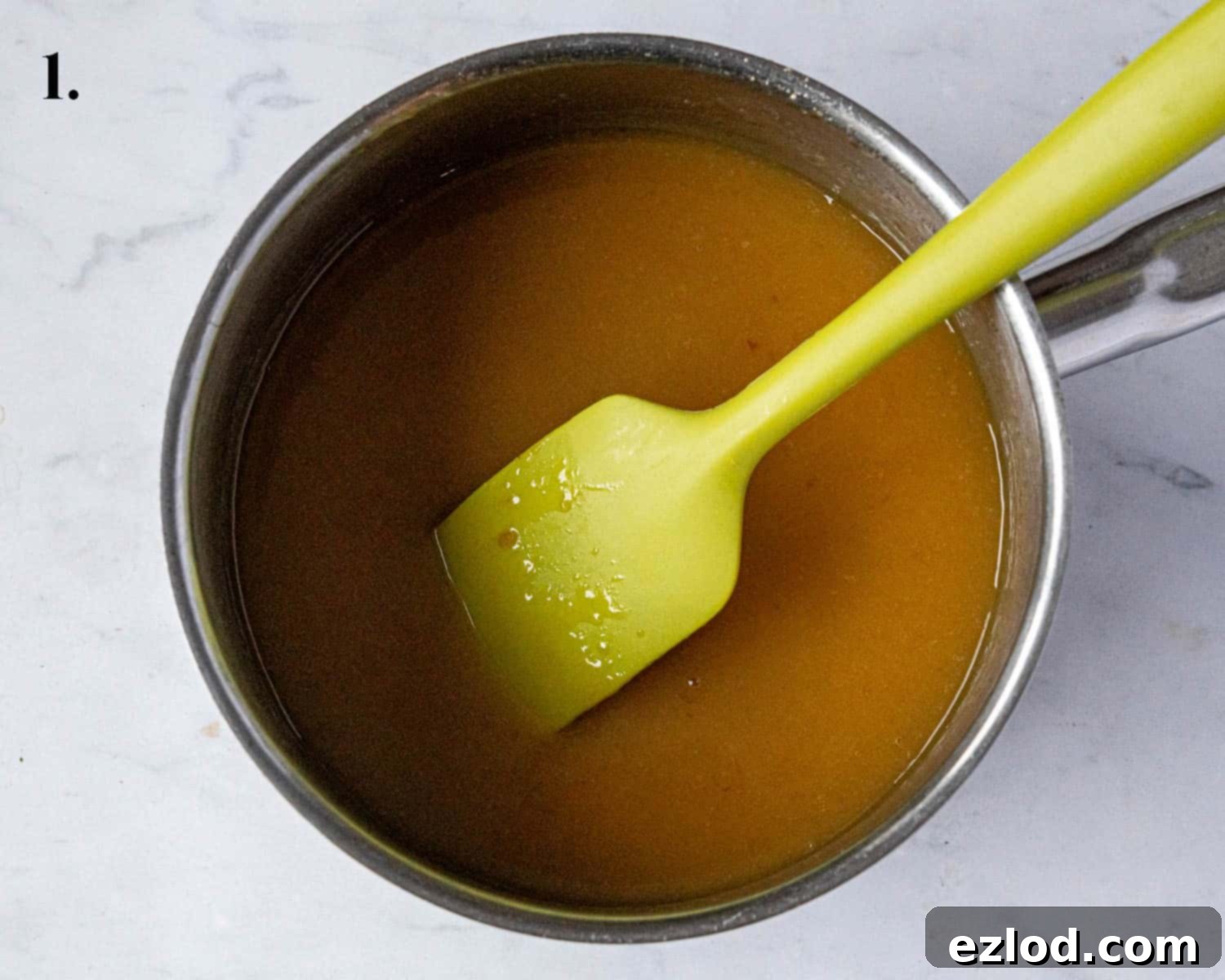
Step 2: Incorporate the Dry Ingredients. Once your wet mixture has cooled slightly, it’s time to add the dry elements. Gently stir in the self-raising flour, mixed spice, and your chosen dried fruit. Mix until just combined, being careful not to overmix. Overmixing can develop the gluten in the flour too much, leading to a tough cake. The batter should be thick and consistent, with no visible dry patches of flour.
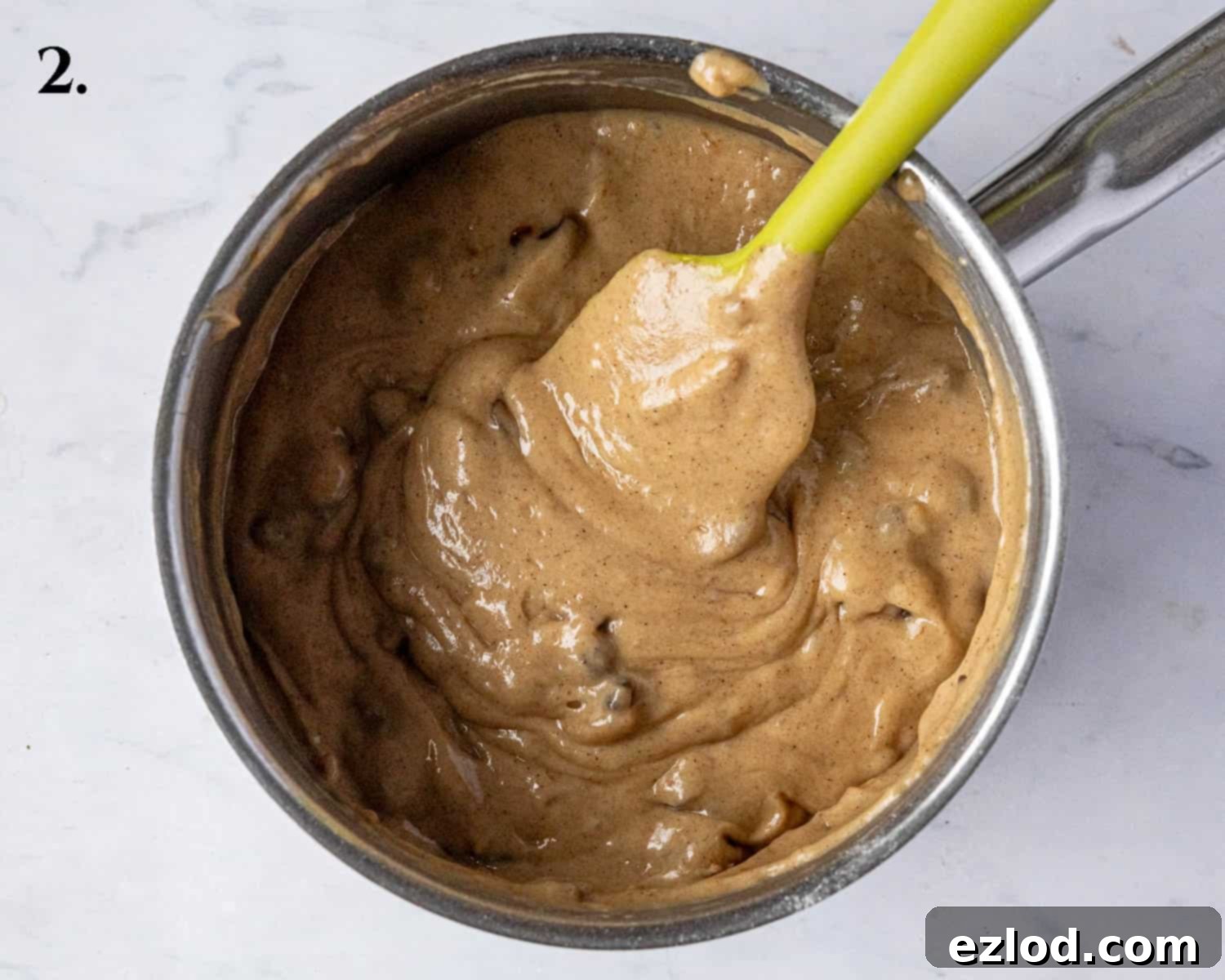
Step 3: Prepare for Baking. Carefully transfer the prepared batter into a greased and lined 2lb loaf tin. Use the back of a spoon or a small spatula to spread the batter evenly across the tin, ensuring a level top. This helps the cake bake uniformly and achieve a beautiful, even crust.
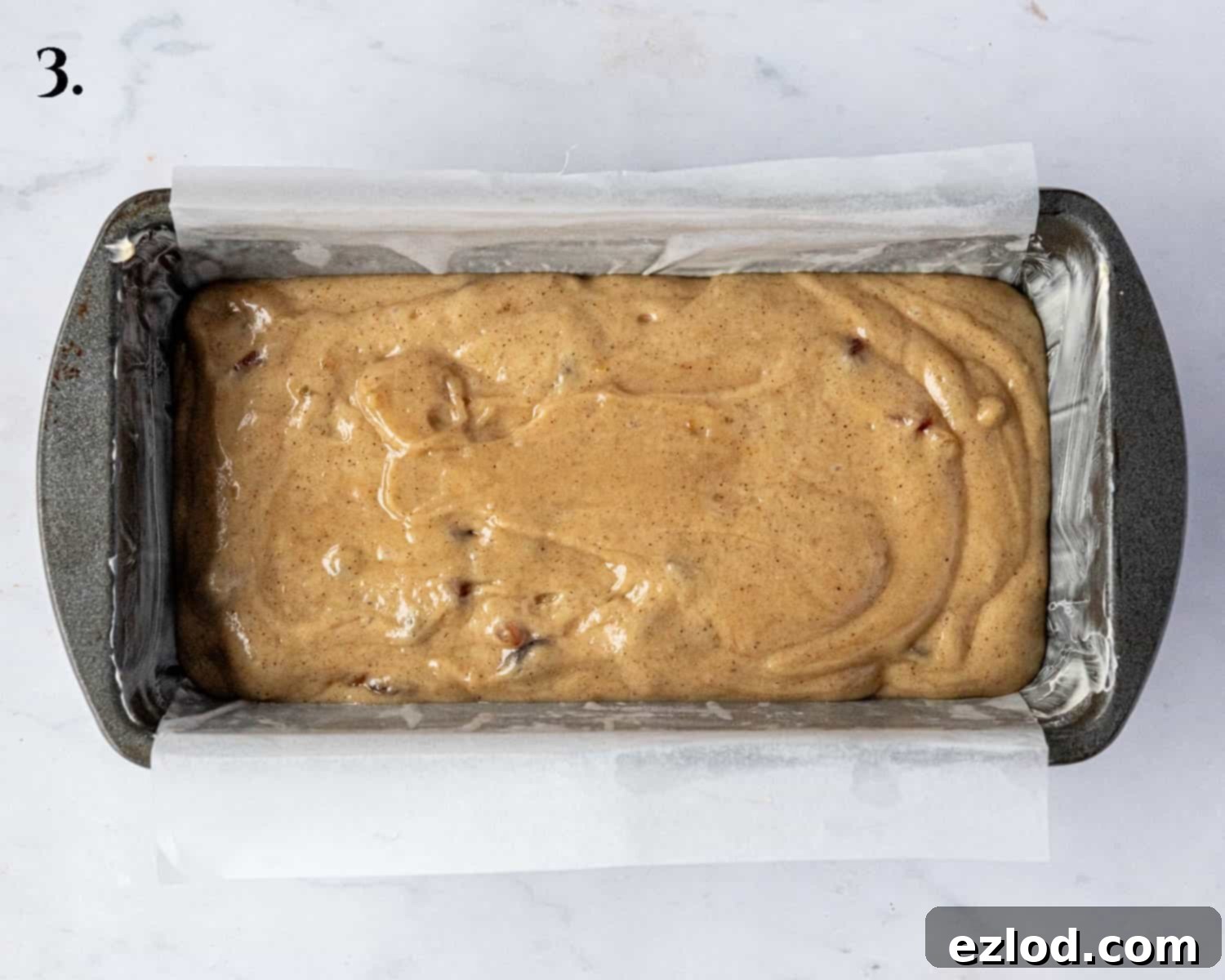
Step 4: Bake to Golden Perfection. Place the loaf tin in your preheated oven and bake for approximately 50-60 minutes. The cake is ready when it is beautifully golden brown on top, firm to the touch, and a skewer inserted into the very center comes out clean. If you notice it browning too quickly, you can loosely tent it with foil during the last 15-20 minutes of baking to prevent over-browning. This ensures a perfectly cooked interior without a burnt exterior.
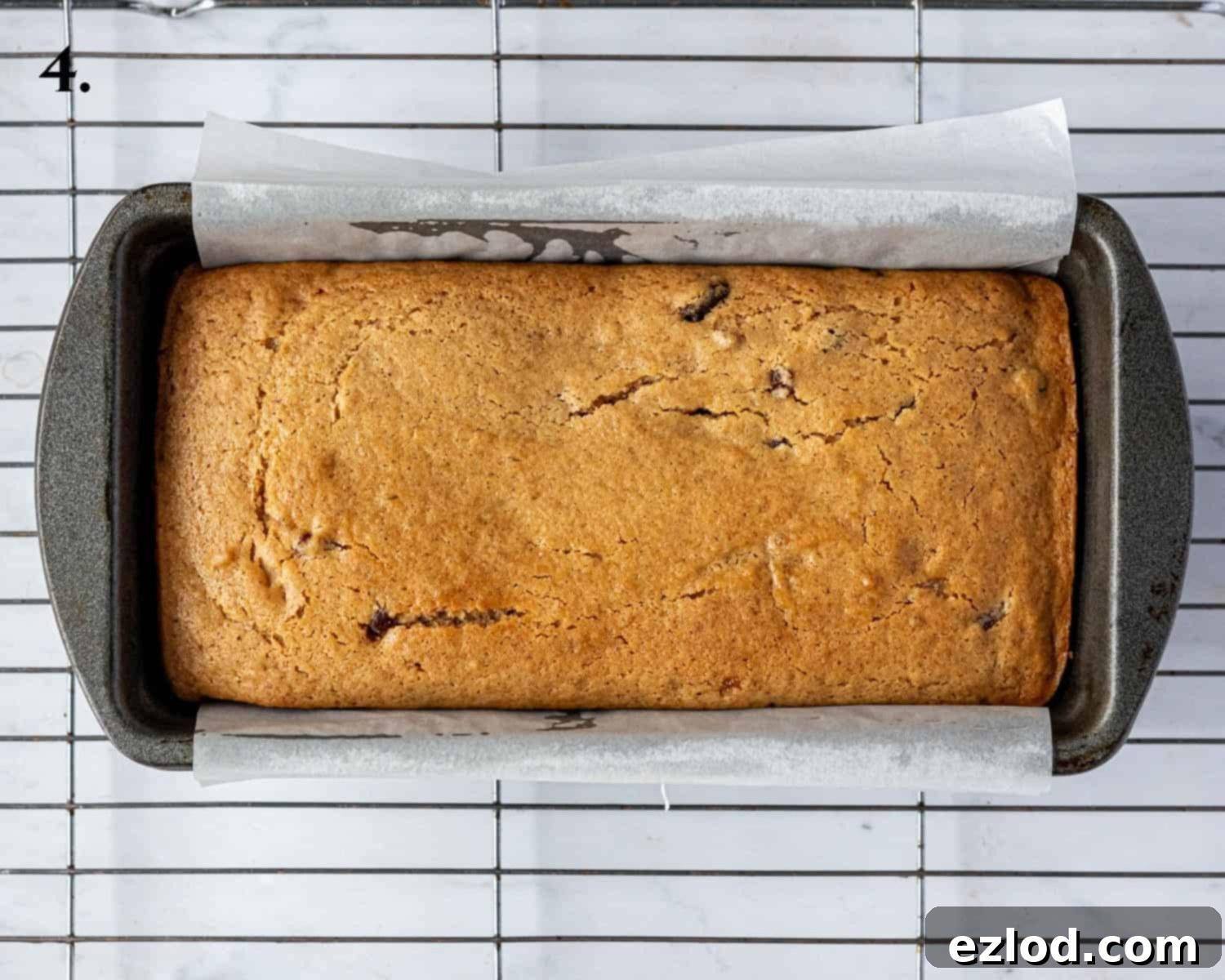
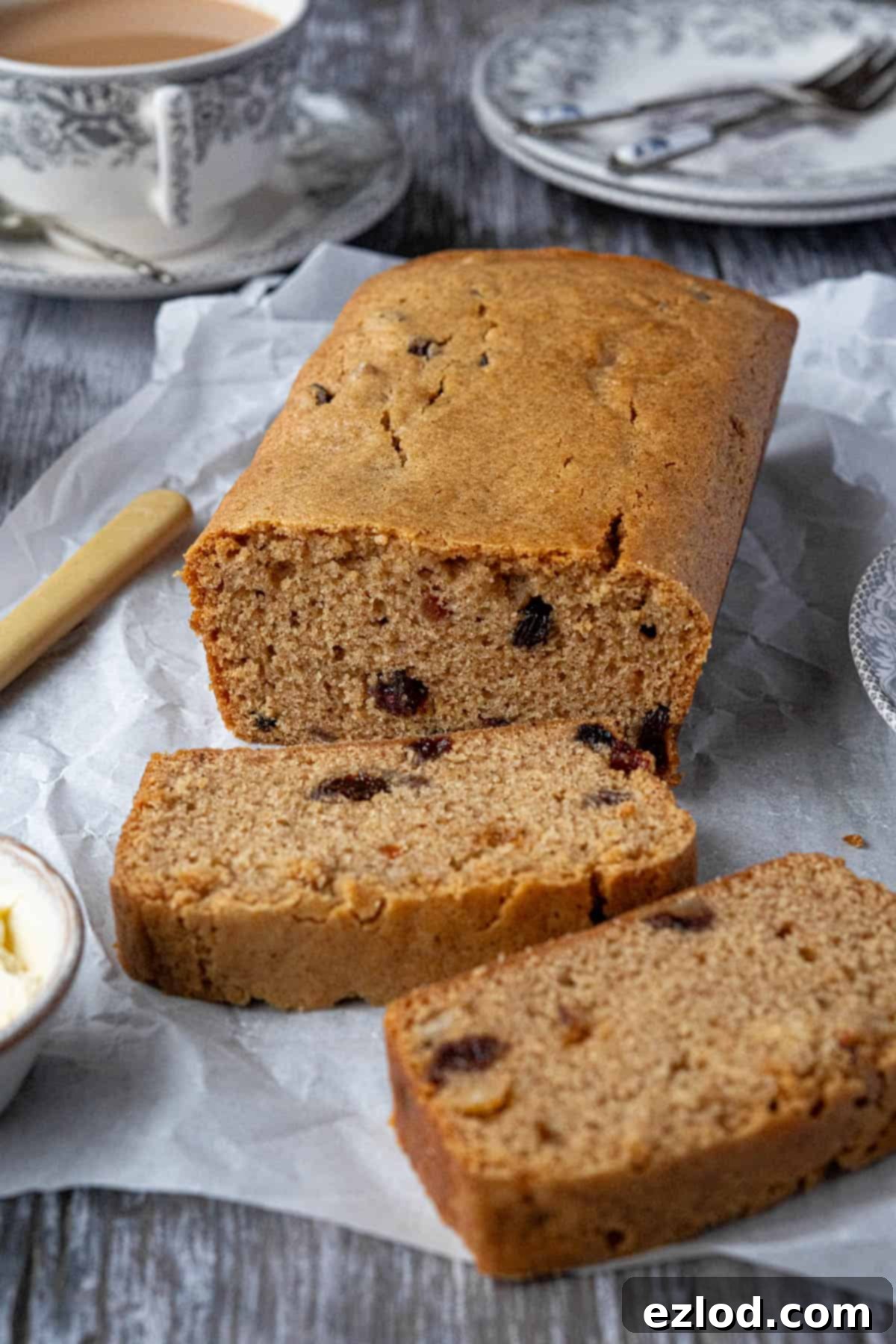
Expert Tips for Baking Your Best Vegan Marmalade Tea Loaf
Achieving a consistently perfect loaf cake is all about precision and a few clever techniques. Here are my top tips to ensure your vegan marmalade tea loaf turns out beautifully every time:
- Embrace the Scales: As with nearly all my baking recipes, I cannot stress enough the importance of using a digital kitchen scale for measuring ingredients. Metric measurements (grams) are significantly more accurate than cup conversions, which can vary wildly depending on how ingredients are scooped and packed. Using a scale guarantees precise ratios, leading to far better, more consistent results, and often makes the baking process cleaner and more efficient!
- The Doneness Test: Knowing when your cake is perfectly baked is key to a moist, tender result. Your marmalade tea loaf is ready when the top is golden and firm to the touch. A classic test is to insert a clean wooden skewer or toothpick into the very center of the cake. If it comes out clean, or with just a few moist crumbs clinging to it (but no wet batter), your cake is done. If it comes out with wet batter, continue baking for another 5-10 minutes and retest.
- Proper Cooling is Crucial: While it’s tempting to dive into a warm loaf straight from the oven, allowing it to cool properly is essential. Let the cake cool in its tin for at least 10-15 minutes before carefully turning it out onto a wire rack. Cooling completely on a wire rack prevents the bottom from becoming soggy and allows the internal structure of the cake to set properly, resulting in a firm yet tender crumb.
- Storage Savvy: This tea loaf keeps exceptionally well! Once completely cooled, store your marmalade tea loaf in an airtight container at room temperature. It will remain fresh and delicious for approximately four days. For longer storage, see the freezing tips below.
- Don’t Overmix: Once you’ve added the flour to the wet ingredients, mix only until just combined. Overmixing develops the gluten in the flour, which can lead to a dense, tough, and chewy cake rather than a light and tender one.
Frequently Asked Questions (FAQ’s) About Vegan Marmalade Tea Loaf
Absolutely! This marmalade tea loaf freezes exceptionally well, making it perfect for meal prep or enjoying a slice whenever you desire. You can freeze it either whole or pre-sliced for convenience. Before freezing, ensure the loaf has cooled completely to room temperature. Wrap it tightly in several layers of cling film (plastic wrap) and then in aluminum foil to prevent freezer burn. It can be stored in the freezer for up to 3 months. To serve, simply allow it to defrost at room temperature for a few hours. You can even gently warm individual slices in a toaster oven for a ‘fresh out of the oven’ feel.
As its name charmingly implies, this tea loaf is best enjoyed as a delightful accompaniment to a warm cup of tea – whether it’s a classic English Breakfast, a delicate Earl Grey, or your favorite herbal infusion. It is utterly delicious on its own, showcasing its rich flavors and moist texture. However, for an added layer of indulgence, it’s also wonderfully enhanced when spread generously with a little vegan butter. You could also serve it with a dollop of vegan cream or even a thin drizzle of extra golden syrup or a light citrus glaze for an extra touch of sweetness and shine.
While I haven’t specifically tested a gluten-free version of this recipe, many readers have successfully adapted similar loaf cakes using a good quality gluten-free self-raising flour blend (often containing xanthan gum). If you try this, ensure your blend is suitable for baking and you might need to adjust liquid slightly as GF flours can absorb differently. Keep an eye on the baking time as well, as it might vary slightly. Always ensure all other ingredients are certified gluten-free if needed.
This recipe is designed for a standard 2 lb (approximately 900g capacity) loaf tin. The dimensions for this typically range around 8.5 x 4.5 x 2.5 inches (21cm x 11cm x 6cm). It’s important to grease and line your tin with baking parchment, ensuring the parchment overhangs slightly on the longer sides. This makes it much easier to lift the baked loaf out of the tin without sticking or breaking.
Explore More Vegan Loaf Cake Recipes!
If you’ve fallen in love with this marmalade tea loaf, you’ll be thrilled to discover a world of other delicious vegan loaf cakes. Perfect for snacking, desserts, or gifting, these recipes are tried and true favorites:
- Hearty Vegan Fruit Cake Loaf
- Moist Vegan Banana Gingerbread Loaf
- Classic Vegan Golden Syrup Cake
- Spiced Vegan Ginger Loaf Cake
- Traditional Vegan Malt Loaf
- Bright and Zesty Vegan Orange Loaf Cake
- Aromatic Vegan Earl Grey Tea Loaf
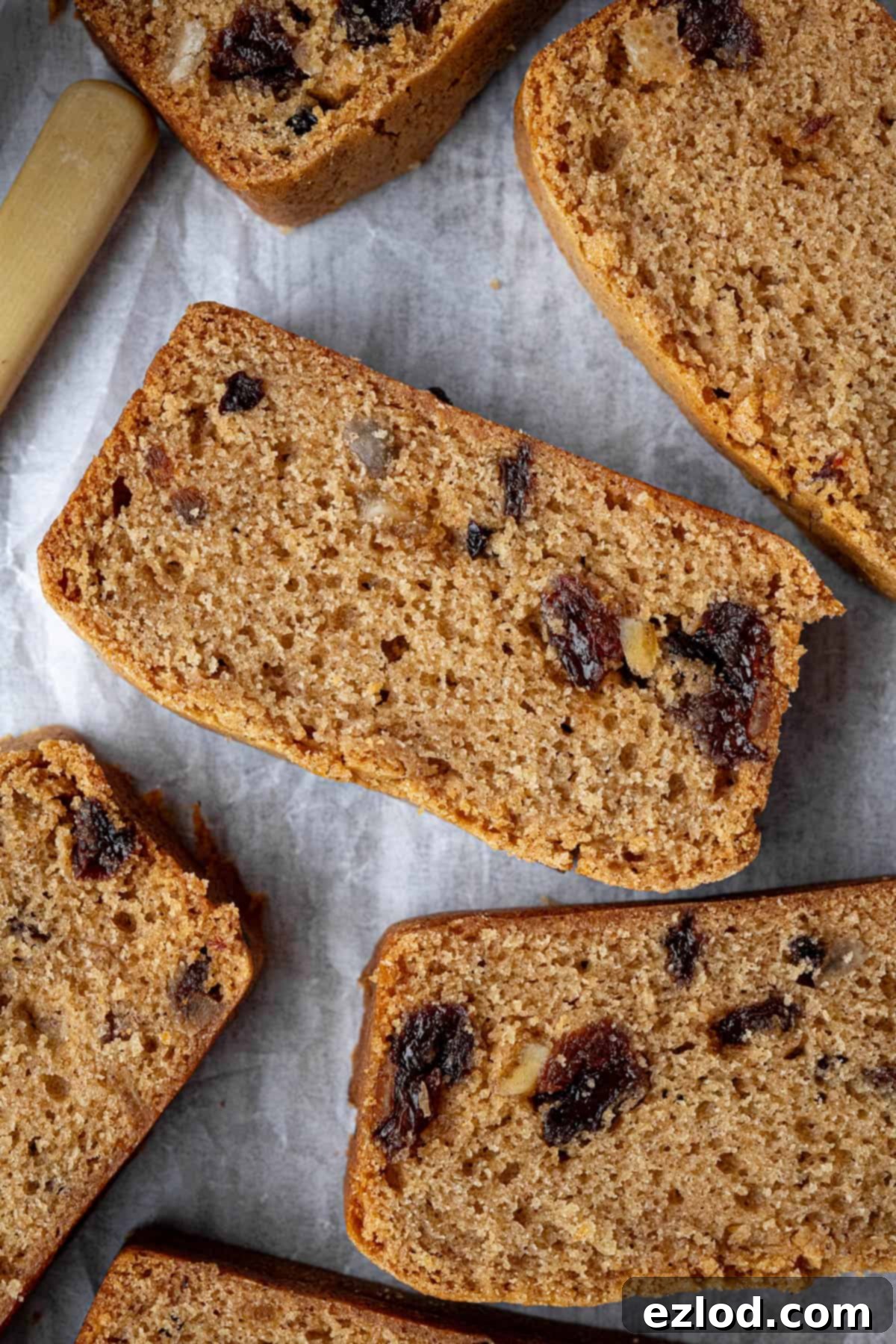
Your feedback is invaluable! If you’ve tried this delightful recipe, please let me know how it went. Don’t hesitate to rate it, leave a comment below, or tag @domestic_gothess on Instagram and use the hashtag #domesticgothess. I love seeing your beautiful bakes!
All images and content published on Domestic Gothess are copyright protected. If you wish to share this wonderful recipe with others, please do so by utilizing the share buttons provided. Kindly refrain from screenshotting or posting the recipe or its content in full. Instead, a direct link back to this post for the complete recipe is greatly appreciated. Thank you for your understanding and support!
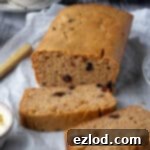
Print
Easy Marmalade Tea Loaf (Vegan)
Ingredients
- 85 g (6 Tablespoons) vegan block butter
- 75 g (6 Tablespoons) caster or granulated sugar
- 50 g (2 Tablespoons) marmalade
- 50 g (2 Tablespoons) golden syrup
- 90 g (6 Tablespoons) unsweetened non-dairy milk (I use soy)
- 175 g (1 ¼ cups + 2 Tablespoons) self-raising flour
- 1 ½ teaspoons mixed spice (or pumpkin spice)
- 100 g (⅔ cup) mixed dried fruit or sultanas
Instructions
-
Preheat the oven to 160℃/140℃ fan/325℉/gas mark 3. Grease a 2 lb loaf tin and line it with baking parchment. Ensure the parchment overhangs slightly on the longer sides for easy removal later.
-
In a medium saucepan, combine the vegan butter, orange marmalade, golden syrup, and sugar. Place the pan over a low heat and stir gently until all the ingredients have melted together into a smooth, liquid mixture. Remove the pan from the heat, then stir in the non-dairy milk. Allow the mixture to cool for about 5-10 minutes until it’s warm but not hot to the touch.
-
To the slightly cooled wet mixture, add the self-raising flour, mixed spice, and your preferred mixed dried fruit. Stir with a spoon or spatula until all the dry patches of flour have disappeared and the ingredients are just combined. Be careful not to overmix, as this can lead to a tough loaf.
-
Pour or spoon the cake batter into the previously prepared loaf tin. Use the back of your spoon or a small offset spatula to spread the batter evenly and level the top. This helps ensure even baking and a beautiful presentation.
-
Bake in the preheated oven for 50-60 minutes, or until the top is golden brown and springs back when gently pressed. To test for doneness, insert a wooden skewer or toothpick into the center of the loaf; it should come out clean or with only a few moist crumbs attached.
-
Once baked, remove the tin from the oven and allow the loaf to cool in the tin for approximately 10 minutes. This helps it firm up and prevents it from breaking when handled. After 10 minutes, carefully lift the loaf out of the tin using the parchment paper overhangs and transfer it to a wire rack to cool completely before slicing and serving.
Notes
- For more detailed tips, ingredient insights, and step-by-step photos that guide you through the process, please refer to the main article above the recipe card.
- ALWAYS USE SCALES FOR BAKING ACCURACY. As emphasized in all my baking recipes, I highly recommend using metric measurements with a digital kitchen scale instead of imprecise cup conversions. Scales provide far greater accuracy, leading to consistently better and more reliable results in your baking. It’s also often a quicker and less messy method than using measuring cups!
